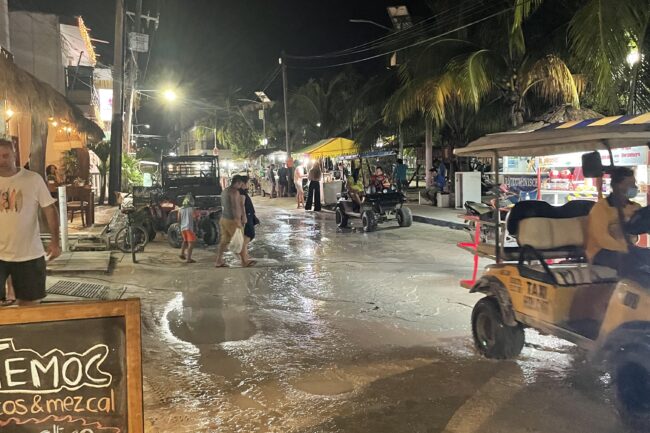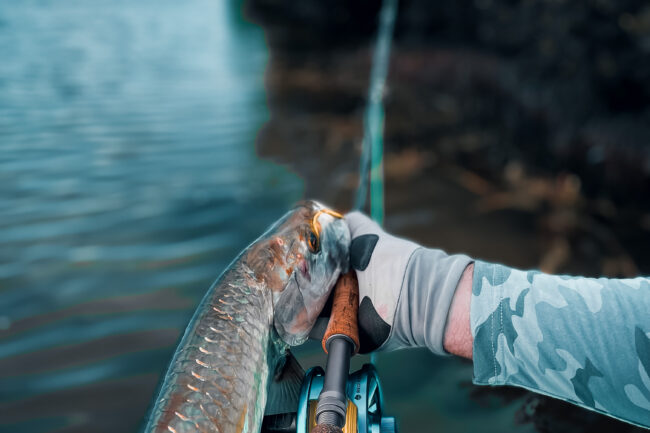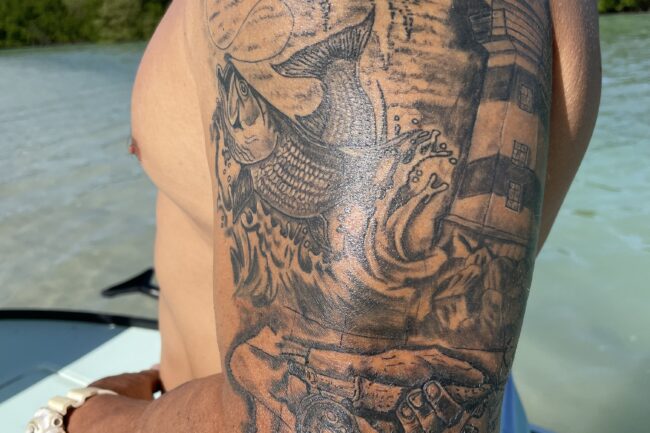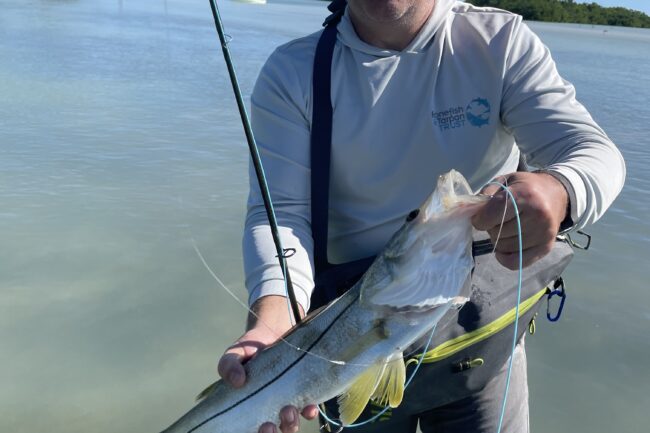Family Beach Vacation with a Side of Tarpon
Story by Michael DeJarnette
Photos by Patrick DeJarnette
Our flight arrived about an hour late in Cancun. It was the Sunday before Christmas, and it had been snowing in Utah. Airports and airlines had been working through significant staffing issues related to the Omicron variant of Covid-19, causing flight cancellations nationwide. Although 6 p.m. doesn’t seem like a late arrival, there was still a two-and-a-half-hour shuttle ride followed by a half-hour ferry boat trip. It really starts to feel late when the journey winds through rural Quintana Roo in a drizzling rain in the dark.
Our ultimate destination was Isla Holbox, an island just off the northeastern tip of Mexico’s Yucatán Peninsula, where the waters of the Caribbean Sea and the Gulf of Mexico intermingle to create a rich marine ecosystem. The island remains laid-back and car-free. There’s enough tourism infrastructure to make it comfortable, but its relative inaccessibility means it isn’t overrun with visitors like some popular beach destinations along Mexico’s Caribbean coast. It would be a welcome holiday getaway for our family—and for me and my son, Patrick, it would afford an opportunity to include fly fishing for baby tarpon in the family vacation plans.
But we weren’t there yet. Ivan was a great driver, although he drove a bit faster than what seemed humanly possible in the wet conditions. The aging Volkswagen van had seen better days. A perpetual oily glaze streaked by the windshield wipers added even more excitement to the drive. When Ivan learned our group was happy to pony up the 175 pesos for the toll road, which would shave half an hour from the trek, there was genuine joy in his eyes.
Our plans hadn’t taken into consideration that the last ferry between Chiquila and Isla Holbox left at 9 p.m., so we were surprised by the fire drill that erupted as the Volkswagen bounced into the ferry station. “Five minutes, five minutes, the last ferry!” We quickly grabbed our bags, bought tickets, and loaded onto the Holbox Express Fast Ferry.
 On the other side of Laguna Yalahau, the boat was unloaded without delay. The port was lively for a rainy Sunday night. Yellow golf carts with lifted suspensions and balloon tires stood in a line, awaiting passengers in the muddy street. We loaded onto two of them, facing backward as we splashed from pothole to pothole through the town center toward the beach road and our hotel, where a long day was followed by a long sleep.
On the other side of Laguna Yalahau, the boat was unloaded without delay. The port was lively for a rainy Sunday night. Yellow golf carts with lifted suspensions and balloon tires stood in a line, awaiting passengers in the muddy street. We loaded onto two of them, facing backward as we splashed from pothole to pothole through the town center toward the beach road and our hotel, where a long day was followed by a long sleep.
With poor fishing conditions on the horizon, we waded through the mire to explore the town on Monday. Holbox is a small fishing village, not unlike many others that time had forgotten until an Instagram-fueled tourism boom washed over small beach towns in the Yucatán. Pictures in front of colorful signs with the names of towns—blue water and white sand in the background—have emboldened even the previously less adventurous to leave the traditional cruise ship ports like Cancun and Cozumel to crowd into sleepy towns like Playa del Carmen and Tulum and startle them awake. Holbox is blessedly still off the beaten path enough to retain its identity as a fishing village. We were reminded of this as we saw an American family walking through soupy, ankle-deep sand in the town center with their shoes in hand, the mother walking as quickly as her bare feet would take her while yelling repeatedly that she was “over this!” I smiled.
 There are still street vendors and markets where English isn’t spoken and credit cards aren’t taken. Prices are in pesos, and cervezas cost about 40 or 50 of them. Culinary highlights include cochinita tacos at the stand at the end of the mini mercado across from the air strip, the empanadas a few doors down, lobster pizza at Roots, and the “meat in its own juice” at La Tapatia.
There are still street vendors and markets where English isn’t spoken and credit cards aren’t taken. Prices are in pesos, and cervezas cost about 40 or 50 of them. Culinary highlights include cochinita tacos at the stand at the end of the mini mercado across from the air strip, the empanadas a few doors down, lobster pizza at Roots, and the “meat in its own juice” at La Tapatia.
Holbox is a place where a beachgoer can walk a couple of hundred yards from the shore and still be in ankle-deep water. The loudest sounds on the island are the gas powered golf carts. You can swim with whale sharks, explore mangroves by kayak, and check out the area’s abundance of marine and bird life. You can also fish.

I connected with Kevin Webb and Darwin Vega Cruz on social media prior to our trip. Having never been to Holbox, I sent messages to a few guides who had pictures of gamefish and fly rods on their feeds. Kevin was the first one who replied, and we eventually booked a few days to chase tarpon and snook on the fly.
Wind and weather didn’t cooperate, but after ongoing conversations with Vega on WhatsApp, the forecast finally became more favorable for fishing on Tuesday. This was set to be a father-son fishing trip like many before it. Patrick was on break from his first semester of college in Boise, and he seemed genuinely excited to be here. Vega was waiting for us at our hotel at 6:15 a.m. We loaded our equipment into his Can Am and drove to the brightly lit port on the south side of town. The ferries and fishing boats had already started their day. Vega loaded us up, untied the Hells Bay, and pointed it into the darkness.
I doubt there’s ever a bad sunrise over the mangroves while going out to fish, but you know it’s exceptional when the guide pulls out his phone for a picture of it. Vega added a couple of images to his phone and then set a course for the mangroves. We approached an opening in the mangroves at full speed and didn’t slow down, effortlessly winding through the trees before coming out into an opening.
 Vega chose a red and white Seaducer from my fly box. We cast at the mangroves for some time and missed a beefy baby tarpon. That empty feeling of missing the trip’s first fish hung in the air for a few minutes. The breeze stiffened as the day progressed, and we moved to a sheltered spot. We switched to a Clouser and waded barefoot in soft sand along the mangroves and missed another baby tarpon. Just as frustration started to creep in, we hooked and landed a snook. But our luck was short-lived; the wind continued to increase and was approaching a gale when we ruled the conditions impossible and called it a day.
Vega chose a red and white Seaducer from my fly box. We cast at the mangroves for some time and missed a beefy baby tarpon. That empty feeling of missing the trip’s first fish hung in the air for a few minutes. The breeze stiffened as the day progressed, and we moved to a sheltered spot. We switched to a Clouser and waded barefoot in soft sand along the mangroves and missed another baby tarpon. Just as frustration started to creep in, we hooked and landed a snook. But our luck was short-lived; the wind continued to increase and was approaching a gale when we ruled the conditions impossible and called it a day.
We returned the next day, only this time, the sky was clear and the wind speed was in single digits. We were developing a good rapport with Vega and he insisted we call him “Darwito,” the name by which most of Holbox knows him. A lifelong resident of the island, Darwito opened up to us about his battle with grief after losing his wife to cancer four years ago. He said the first three years were dark, but a year ago he got sober and started focusing on the health of both his body and mind. He told us he works out everyday, which was obvious when he showed us the story in black ink on his left arm, an extensive tattoo telling an artful story of triumph and tragedy through images of fly rods, skiffs, and tarpon.
We arrived at the mouth of a creek in the mangroves and saw the baby tarpon rolling. The mosquitos had started to bite, which seemed to excite Darwito. He told us that the mosquitos bring the tarpon. He was probably just trying to make us feel better, but we went along with it, and after a few overly excited casts, a yellow and white Clouser finally found its mark in a cut in the mangroves. The tarpon ate, and the dance had begun. We call them baby tarpon, but they feel bigger than babies when they jump. The silver prince earned his bow before I brought him to the boat. Somehow my 9-weight snapped at a ferrule just as we landed the fish, but I considered it a small price to pay for the experience (and the rod has a good warranty), and it didn’t dampen the celebration.
 We moved to a canal in the middle of the mangroves and backed into the trees, making long casts across the channel as tarpon rolled by. We lost a few flies in the tricky back casts, but we were rewarded by a good-sized shiny silver specimen. The tarpon fought hard to get into the mangrove roots, but finally relented as a young sea turtle looked on.
We moved to a canal in the middle of the mangroves and backed into the trees, making long casts across the channel as tarpon rolled by. We lost a few flies in the tricky back casts, but we were rewarded by a good-sized shiny silver specimen. The tarpon fought hard to get into the mangrove roots, but finally relented as a young sea turtle looked on.
We fished more and talked more, but once again the wind picked up and sent us to port. My wife and daughter thought this was a beach vacation and not a fishing trip, so there were family obligations. But any time a family vacation during the week before Christmas can be tweaked to include a few days of skiffs, tarpon, and fly rods, it’s a success. Holbox is a place where this can be done.
Hopefully, Holbox never paves the roads. It would be a shame for the traffic to get to the levels that are now seen in Tulum and other previously unknown beach destinations. For now, it’s still an escape for both the vacationer and the angler who prefers to be away from crowds and is willing to give up a bit of comfort to do so.
Fly Fishing the Lowcountry – Part Three: Migratory Species of the Lowcountry


